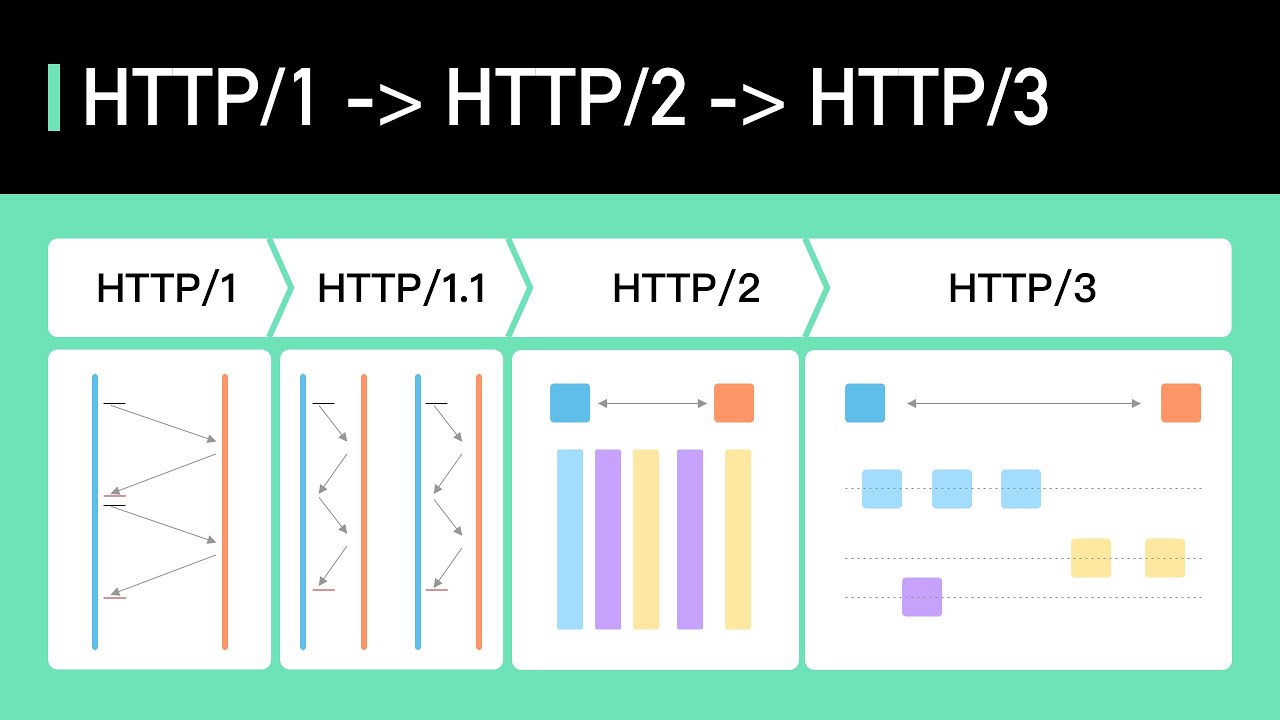In today's digital landscape, speed is crucial for online success. Websites that load quickly and efficiently are more likely to attract and retain visitors, leading to higher engagement and conversion rates. As search engines continue to prioritize user experience, speed has become an essential factor in search engine optimization(SEO).
Let's explore an http3 guideand discuss the benefits of HTTP/3 and delve into the specifics of how it speeds up website performance to meet the need for speed in SEO.
HTTP3 Guide - Understanding HTTP/3
HTTP/3 is the latest version of the Hypertext Transfer Protocol (HTTP), designed to optimize website performance by improving speed, reliability, and security. It is based on the QUIC protocol, which stands for Quick UDP Internet Connections.
How HTTP/3 Speeds Up Website Performance
To fully appreciate the advantages of HTTP/3, let's step back and understand the problems that HTTP/2 aimed to solve.
The Challenges Of HTTP/1.1 And HTTP/2
HTTP/1.1, the previous version of the protocol, was designed to give each file its own connection. However, as websites became more complex, the number of files needed to load each page increased, leading to slower loading times. Browsers limited the number of parallel connections available, creating a bottleneck in the loading process. To maximize performance, workarounds like domain sharding and image sprites were implemented, but they weren't perfect solutions.
For example, let's say a website has multiple CSS and JavaScript files. With HTTP/1.1, each file required a separate connection, which meant that the browser had to establish multiple connections, leading to increased latency. This resulted in slower page load times, negatively impacting user experience and SEO.
HTTP/2 addressed these issues by introducing multiplexing, which allowed multiple files to be transferred simultaneously over a single connection. This reduced connection overhead and improved performance. For example, using HTTP/2, the browser could request multiple files in parallel and receive them over a single connection. This significantly improved the loading speed of web pages, leading to a better user experience.
However, head-of-line blocking remained a problem. When a packet was lost, the entire connection was held up until the lost packet was successfully received, limiting the benefits of multiplexing.

HTTP/3 Explained with Animation
Independent Byte Streams And Improved Security
HTTP/3 solves the head-of-line blocking problem by introducing independent byte streams for individual files. Now, if a packet is lost, only the data for that particular stream is blocked until the lost packet is resent, allowing other streams to continue transmitting. This results in faster and more efficient data delivery.
To illustrate this concept further, let's consider a scenario where a web page has multiple resources such as images, CSS files, and JavaScript files. With HTTP/3, these resources can be sent independently, and if there is an issue with one of the packets, only the affected resource is affected, and the other resources can continue to be transmitted. This improves the overall speed of the web page and enhances the user experience.
Additionally, HTTP/3 integrates TLS 1.3 into the protocol itself, reducing the number of round trips required to establish a secure connection. This improves the connection speed and enhances security. By combining the benefits of HTTP/2's multiplexing and improved security measures, HTTP/3 offers a significant performance boost for websites.
Seamless Connection Migration
In a mobile-first world where users frequently switch between Wi-Fi and cellular networks, connection stability is crucial. HTTP/3 addresses this by using connection IDs instead of IP addresses to route packets. This allows for seamless network changes without the need to re-establish connections. Users can switch between different networks, such as Wi-Fi and cellular, without interruptions, ensuring smoother and more stable connections.
For example, imagine a user is browsing a website on their mobile device while connected to a Wi-Fi network. If the user moves out of Wi-Fi range and switches to a cellular network, HTTP/3 enables the website to seamlessly continue transmitting data over the new network without disruptions. This ensures a smooth browsing experience for users, regardless of their network conditions.
The Advantages Of HTTP/3 Over HTTP/2 And HTTP/1

HTTP/1 to HTTP/2 to HTTP/3
HTTP/3 provides several advantages over its predecessors, including:
Elimination Of Head-of-Line Blocking
With independent byte streams, HTTP/3 minimizes the impact of packet loss. Only the data for the affected stream is blocked until the lost packet is resent, allowing other streams to continue transmitting. This results in faster and more reliable data transmission.
For example, consider a web page with multiple images. If a packet loss occurs while transferring one image, HTTP/3 ensures that only the affected image is delayed, while the remaining images continue to load. This improves the overall loading speed and prevents delays caused by packet loss.
Integrated TLS For Faster And More Secure Connections
By incorporating TLS 1.3 into the protocol itself, HTTP/3 reduces the number of round trips required to establish a secure connection. This leads to faster and more secure connections for users, improving both speed and security.
For instance, when a user accesses a website using HTTP/3, the negotiation of a secure connection is optimized, resulting in reduced latency and quicker loading times. This enhances the user experience and provides an additional layer of security.
Seamless Connection Migration
HTTP/3's use of connection IDs allows for seamless network changes without the need to re-establish connections. This is particularly advantageous in a mobile-first world where users frequently switch between different networks, ensuring smoother and more stable connections.
For instance, if a user is watching a video on a website using HTTP/3 and transitions from Wi-Fi to a cellular network, the video stream seamlessly switches to the new network without interruption or buffering. This ensures a seamless user experience, regardless of network changes.
Improved Performance On Slower Connections
HTTP/3's use of UDP and reduced connection overhead contribute to improved performance, especially on slower network connections. This is crucial for providing a better user experience to users with limited bandwidth or unstable connections.
For example, users with slower internet connections may experience improved website performance when using HTTP/3. The reduced connection overhead and optimized data transmission lead to faster loading times and smoother browsing, even under challenging network conditions.
Better Core Web Vitals Scores
Core Web Vitals, a set of metrics that measure the user experience on websites, can be positively influenced by the improved performance and reduced latency offered by HTTP/3. This can lead to better overall website rankings in search engineresults.
For instance, one of the core metrics, Largest Contentful Paint (LCP), measures the time it takes for the largest element on a page to become visible. With HTTP/3's enhanced speed and efficiency, websites can achieve faster LCP times, contributing to better Core Web Vitals scores and improved SEO performance.
Implementing HTTP/3 For SEO Success
To take advantage of HTTP/3 and optimize website performance, consider the following steps:
Check Server Compatibility
Ensure that your hosting provider or system administrator supports HTTP/3. Verify that your server infrastructure is up to date and compatible with the necessary protocols.
For example, if you are using a popular Content Management System(CMS) like WordPress, check if your hosting provider supports HTTP/3 or if there are any plugins or server configurations available to enable it. Many hosting providers offer support for HTTP/3, especially those that prioritize performance and speed.
Enable HTTP/3
Work with your technical team to enable HTTP/3 on your server. This may involve configuring your web server software or utilizing a ContentDelivery Network (CDN) that supports HTTP/3. Consult the documentation provided by your server or CDN provider for specific instructions.
For example, if you are using Cloudflare as your CDN, you can easily enable HTTP/3 in the Cloudflare dashboard. Cloudflare provides a simple toggle switch to enable HTTP/3 for your website.
Optimize Web Content
While HTTP/3 significantly improves website performance, optimizing your web content further enhances its benefits. Compress images, minify code, reduce the number of HTTP requests, and implement caching techniques to minimize load times and improve overall performance.
For example, instead of using uncompressed images, use image compression techniques to reduce their file size without compromising quality. Minify your CSS and JavaScript files to remove unnecessary whitespace and comments, resulting in smaller file sizes and faster loading times. Additionally, implement browser caching to store static resources locally, reducing the need to fetch them from the server for subsequent visits.
Monitor And Analyze Performance
Regularly monitor and measure your website's performance to ensure that HTTP/3 is delivering the expected results. Utilize tools such as Google PageSpeed Insights, WebPageTest, or your CDN's performance monitoring features to assess the speed and performance of your website. Identify areas for improvement and fine-tune your implementation for optimal results.
For example, use Google PageSpeed Insights to analyze your website's performance and receive actionable recommendations for further optimization. Monitor key performance metrics such as page load time, time to first byte (TTFB), and Total Blocking Time (TBT) to evaluate the impact of HTTP/3 on your website's speed and user experience.
People Also Ask
What Is The Key Goal Of HTTP3?
Initially referred to as 'HTTP-over-QUIC', HTTP/3 aims to ensure compatibility between the HTTP syntax and all the existing functionality of HTTP/2 with the QUIC transport protocol.
Should I Enable Http3?
Yes, enabling HTTP3 is crucial and it's highly recommended to stay updated with it. Similar to the significant changes introduced by HTTP/2, which transitioned from ASCII to binary, HTTP3 brings important advancements that you should embrace.
Which Website Uses Http3?
The following websites utilize HTTP/3:
- Auth0.openai.com, accounting for 4% of the traffic.
- Chat.openai.com, accounting for 4% of the traffic.
- Api.whatsapp.com, accounting for 2% of the traffic.
- Accounts.shopify.com, accounting for 1% of the traffic.
What Browsers Support HTTP 3?
HTTP/3 is supported by various browsers. Chrome and other Chromium-based browsers such as Edge fully support HTTP/3. Additionally, Firefox and Opera, both on desktop and mobile, also have built-in support for HTTP/3. However, it's worth noting that as of the current time, Safari on both desktop and mobile-only offers experimental support for HTTP/3, which can be enabled through the developer tools. In practical terms, it's unlikely that regular users will enable this experimental feature themselves.
What Are The Limitations Of HTTP 3?
HTTP/3 comes with certain limitations that should be considered:
One limitation is that transitioning to HTTP/3 requires not just a change in the application layer but also a change in the underlying transport layer. This makes the adoption of HTTP/3 slightly more challenging compared to its predecessor, HTTP/2, which only required a change in the application layer.
Conclusion
HTTP/3, the latest version of the HTTP protocol, brings significant improvements in website performance and speed. By addressing the limitations of previous versions, such as head-of-line blocking and connection establishment delays, HTTP/3 optimizes data transmission, reduces latency, and enhances the user experience.
With features like independent byte streams, integrated TLS, seamless connection migration, improved performance on slower connections, and better Core Web Vitals scores, implementing HTTP/3 can significantly contribute to SEO success by providing faster-loading websites that engage users and improve search engine rankings. Stay ahead of the competition and make use of this http3 guide to meet the need for speed in the ever-evolving digital landscape.
